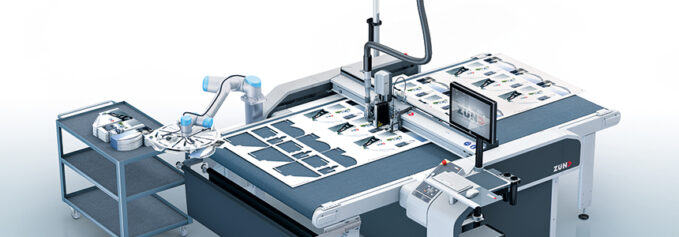
by Industrial Print Magazine staff
With labor shortages higher than ever, now is the time to implement automated media handling devices into digital print workflows. For corrugated boards this is especially important as the material is known to be unwieldy at times. Media handling pertains to all sorts of parts of the production floor, from loading and unloading mechanisms to robotic arms that move media from point A to point B. Here, we look at the rise in demand for automated handling systems, specifically a focus on corrugated board.
Above: Any user can convert their Zünd cutter into an automated production machine.
Rise in Demand
Increasing efficiencies and minimizing manual errors can be attributed to any form of automation. Particularly in terms of media handling, tools like loading and unloading mechanisms as well pickers and robotic arms are seeing a huge explosion in demand.
Digital print’s rise in popularity is a direct influencer. “The rise in digital print has given customers the possibility to produce more personalized, small- to medium-sized production runs. On one pallet or stack there may be many different jobs, with varying types of media, all with different print, cut, and crease requirements. Digital, industrial automation is the answer, as media can be automatically handled from pre-print to post finishing—cutting and creasing. Moving forward, we foresee the growth in automation continuing with increased collaborations with printer manufacturers,” notes a representative from Elitron.
“Particularly in the short-run market, a growing need for automation allows packaging providers to bring short-run production in house and make digital production lines efficient and profitable—from prepress to dispatch,” agrees Martin Thornton, business segment manager, Zund America, Inc.
For any material being decorated—or in our case digitally printed—the need to move it quickly off a press is increasingly becoming a challenge. “As digital systems increase in speed and replace traditional analog printing systems more frequently, we see an increased need for automated material handling systems to enable fast and efficient digital production. We think this trend will continue as digital equipment speeds increase and more automation is needed,” foresees Steve Lynn, director labels and packaging, Durst North America.
Beyond simple unloading and loading, robotics are growing, says Thornton. “Robotics, especially for picking and sorting. The more traditional feeding-cutting-stacking workflow is enhanced with robotic picking and sorting, where cut pieces are stripped and stacked by a robotic device, while the conveyor offloads any remaining waste that may have been previously sliced for easy disposal and recycling.”
Corrugated Focus
Corrugated media, used for boxes, packaging, even point of sale displays, finds automated material handling mechanisms advantageous. The composition of the material in question makes it benefit from these automated processes.
Without a loading system or automation, the representative from Elitron believes the entire process is far more labor intensive. “For the production of small- to medium-sized runs, of both printed and non-printed corrugated, integrated, digital industrial automation is the optimum solution for high-quality, display and packaging production.”
“Automated media handling is very important for corrugated print production to reduce manual intervention and material handling time through digital print equipment. Corrugated material typically has some warp/curl, so automated handling systems must be able to feed sheets reliably and keep corrugated board flat and stable throughout the feeding, print, drying, and stacking process,” adds Lynn.
Most people working with corrugated board should take advantage of automation technology.
“Corrugated converters and companies who are producing printed boxes or display graphics on corrugated board will need to take advantage of automated sheet handling systems to maximize productivity in their operations,” suggests Lynn.
“Brown box applications, both printed and unprinted, benefit from material handling automation. Digital production is particularly advantageous in this environment, eliminating the need to purchase expensive tooling and gaining complete control over every phase of the production process,” adds Thornton.
Important Features of Note
When adding a media handling device, features like scalability, cost, hardware/software compatibility, and footprint must be looked at in relation to a buyer’s existing digital print workflow.
“Buyers should evaluate what they want to achieve in terms of automation and naturally look at any possible physical barriers in the production plant,” notes the representative from Elitron.
Lynn recommends buyers ensure that the material handling device they are purchasing can actually handle board that is not perfectly flat—for example corrugated media.
Another important factor to consider, that the material handling mechanism works with the software currently in place. “Buyers should ensure that the handling equipment interfaces seamlessly with digital print production equipment mechanically and has a software automation interface that allows seamless production from feed to completed print. Adding material automation will increase the footprint of a system but it is required for fast production and to reduce the cost of manual labor for feeding to maximize profitability,” says Lynn.
“As is the case with any type of automation the key is in the ease of integration as well as, ultimately, in reliability. As we have all experienced, automation is worse than no automation if it doesn’t perform reliably,” cautions Thornton.
Scalability should be looked at. For example, depending upon the level of automation and the budget, Elitron works closely with customers to ensure they install a system to meet today’s requirements, but ready to handle tomorrow’s challenges too.
Modularity is another item to be addressed.” Packaging providers should also take care to choose components that offer modularity and open architecture. Automation features—just like all other components in the production line—almost need to be flexible enough to accommodate the requirements specific to the packaging manufacturer as well as the ever-changing demands in the marketplace,” advises Thornton.
Now More than Ever
Automation is more important than ever. While it can be said that it is essential in all industries, for all facets of the production process, it is especially helpful when it’s working to minimize manual errors and deal with challenging pieces of materials moving throughout a digital printing workflow.
“There is a growing demand from printer manufacturers to have automated media handling options. Buyers are starting to look beyond automatic loading/feeding, sheet turning, and unloading and now are directing their interest towards a turnkey solution with media stack management too,” says the representative from Elitron.
One example of material benefiting from automated handling systems is corrugated media. If you’re looking to learn more about corrugated media, be sure to check out our preview of Corrugated Week. IPM
Sep2022, Industrial Print Magazine



